Mark Sisson's Blog, page 223
May 8, 2016
Weekend Link Love – Edition 399

Host Brad Kearns celebrated the 50th episode of the Primal Endurance Podcast by bringing video into the mix. More to come.
Elle Russ, author of the upcoming book, The Paleo Thyroid Solution, chats with Abel James.
Research of the Week
A third of all antibiotic prescriptions are totally unnecessary.
Medical error is the third biggest killer in the US.
Faster metabolic rates made our big brains possible.
Genes aren’t everything: active twins are leaner than their sedentary twins.
Biggest Loser contestants really, really struggle with weight maintenance.
Longer rest periods may be better for muscle protein synthesis.
In women with PCOS, grazing beats three meals.
New Primal Blueprint Podcasts

Episode 118: Brad Kearns and Elle Russ: Hosts Brad Kearns and Elle Russ discuss a variety of topics, drawing on reader comments and questions. How does genetic makeup interact with carb metabolism? Is testosterone sensitive to the demands placed on the body? What are Elle’s tips for writers? Find out all that and more.
Each week, select Mark’s Daily Apple blog posts are prepared as Primal Blueprint Podcasts. Need to catch up on reading, but don’t have the time? Prefer to listen to articles while on the go? Check out the new blog post podcasts below, and subscribe to the Primal Blueprint Podcast here so you never miss an episode.
Why Weight Loss Doesn’t Promise Happiness
Interesting Blog Posts
An ultimatum from the Dietary Guidelines chairwoman Barbara Millen got Nina Teicholz kicked off the National Food Policy Conference panel.
We’re losing our Neanderthal genes.
Southern California vegan restauranteurs turn out to be murderers who enslave animals on their farm and keep freezers full of cow flesh.
Media, Schmedia
The rise and fall of Theranos, the company that promised to track every biomarker worth tracking with a single drop of fingertip blood.
Dr. Aseem Malhotra thinks the benefits of statins have been greatly exaggerated. Another good piece from him: “When I go to my local curry restaurant, I always ask the waiter to make sure my chicken jalfrezi, spinach curry and lentil daal is cooked in ghee, not vegetable oil.”
The world (and many lucrative endorsements) of Dr. David Katz.
Everything Else
The vast difference between what foodies (say they) cook and what actual home cooks cook.
Beware the trash panda.
Walt Whitman would have fit in nicely around these parts.
Nature is brutal and beautiful.
Hershey’s entering the meat bar business.
More “human safaris,” this time in Peru.
Recipe Corner
Simple and spicy grilled thai beef salad.
A great strawberry shake from Abel James.
Time Capsule
One year ago (May 11 – May 17)
Is All Yogurt Created Equal? – All about yogurt.
Primal Flora: Your Questions Answered – Probiotics question roundup.
Comment of the Week
He is Vego! You are like buzzing of flies to him.
– Excellent comment. In case you don’t know what His Dudeness was referring to, watch this.




May 7, 2016
One Sheet-Pan Roasted Salmon and Red Cabbage
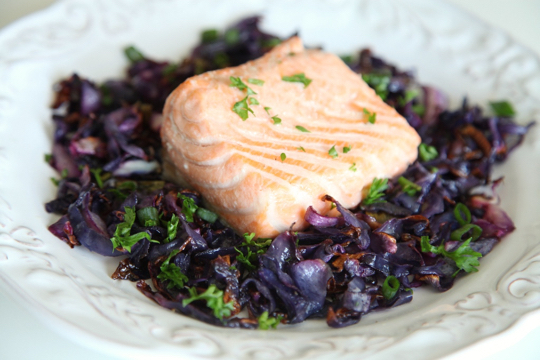 There’s nothing better than a meal that leaves you only one pan to wash. In this recipe, red cabbage and scallions are roasted on the same pan as salmon (or other fish of your choice). It’s a simple but gorgeous meal, and one that can be eaten hot out of the oven or cold the next day mixed with salad greens.
There’s nothing better than a meal that leaves you only one pan to wash. In this recipe, red cabbage and scallions are roasted on the same pan as salmon (or other fish of your choice). It’s a simple but gorgeous meal, and one that can be eaten hot out of the oven or cold the next day mixed with salad greens.
Red cabbage is used here for its eye-catching color, but this cruciferous veg has so much more going for it than just looks. Sulfur-rich and boasting a whopping thirty-six different anthocyanins, that purple color is screaming out “antioxidants!”
Roasting shredded cabbage turns the shreds into frizzled bits that are both tender and crispy. Served with fatty salmon, the combination of cabbage and fish is a super-healthy, super-satisfying meal.
Servings: 4
Time in the Kitchen: 50 minutes
Ingredients:

4 6-ounce/170 g pieces salmon fillets (or other fish), about 1-inch/2.5 cm thick, patted dry
1 small head red cabbage, shredded
8 scallions, chopped
3 tablespoons avocado oil or extra virgin olive oil, plus more to coat fish (45 ml)
1/4 cup finely chopped fresh parsley (60 ml)
Instructions:
Preheat oven to 425 °F/218 °C.
Rub fish with olive oil or avocado oil and season with salt and pepper. Set aside.
Toss shredded cabbage with most of the scallions (save a small handful for garnish) and the oil. Lightly salt and pepper. Spread the cabbage and scallions out evenly on a rimmed baking sheet (18×13 is a good size) Cook 25 minutes.
Stir the cabbage and scallions and push to the sides of the pan, making room for the fish fillets in the middle. Place the salmon skin side down. Roasting time depends on the thickness of the salmon—about 8 minutes per/inch is usually about right.
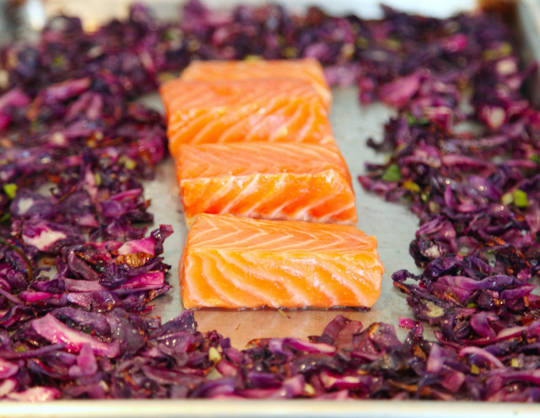
Top with parsley and remaining scallions before serving.
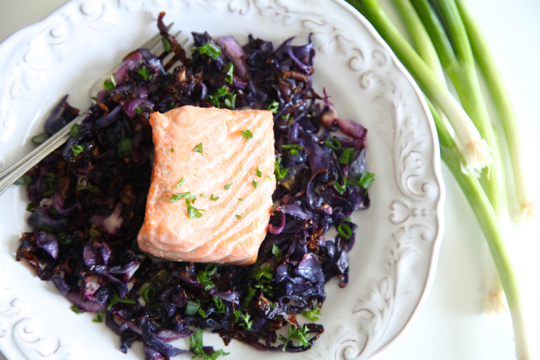




We Need PRIMAL KITCHEN™ Brand Ambassadors in Chicago and Florida!
 Calling all Primal Kitchen enthusiasts! Do you love our products? Does the idea of educating others on the benefits of wholesome, healthy, delicious ingredients pique your interest? Looking for some fun, flexible, part-time work? Then today is your lucky day! We’re expanding our Brand Ambassador team in the Chicago and Florida areas.
Calling all Primal Kitchen enthusiasts! Do you love our products? Does the idea of educating others on the benefits of wholesome, healthy, delicious ingredients pique your interest? Looking for some fun, flexible, part-time work? Then today is your lucky day! We’re expanding our Brand Ambassador team in the Chicago and Florida areas.
If you (or someone you know) meet the requirements from the list below, and you’re looking for work with lots of control over your schedule, please apply by filling out the application and emailing your resume to sierra@primalkitchen.com. Go over our Brand Ambassador checklist and see if you’re a match. If you are, then you might be snagging one of the hottest positions in Chicago or Florida.
Requirements:
You love hanging out in Whole Foods or your local natural grocery store
You have an outgoing personality and you’re incredibly charming and fun
You live a Primal lifestyle
You have a general understanding of why avocado oil is the best oil—and you’re not afraid to educate shoppers
You like to talk
You have wheels
You live in either the Chicago area or in Florida
You have a smartphone (for recording information from your demo)
If you think you’d make a good fit, apply here!



May 6, 2016
Share Your Success Story, Win a Year’s Supply of PRIMAL KITCHEN™ Mayo!

Do you have a Primal Blueprint Success Story you’d like to share? Then I want to hear from you!
Write it up and include a photo. Including both pre-Primal and post-Primal pics is best, but not required. Don’t worry if you’re not a chiseled Adonis. This isn’t a “who’s the most ripped” contest. Whether you’ve lost 100 pounds over two years of Primal living or you’ve simply managed to kick that Diet Coke habit, just tell me what going Primal has done for you. I’m looking for interesting and personal tales.
You can include details about your health history, how you found MDA and The Primal Blueprint, what has worked and what hasn’t, what differences you’ve seen in how you look and feel, and anything else you think readers might be able to learn from (that you’re open to sharing) are welcome. It doesn’t have to be a thousand word diatribe, but more than a couple paragraphs is best. Feel free to be creative with your story format, too. Remember, good stories usually have a beginning, a middle, and an end. And of course, honesty is king.
If you’ve ever thought about sending in your story but haven’t gotten around to it, then there is no better time than now!
 The Prize
The PrizeA year’s supply of PRIMAL KITCHEN™ Mayo! That’s three jars of either my original avocado oil-based mayo, three jars of the new Chipotle Lime Mayo, or any combo of three, per month! Winner’s choice!
Examples
There are tons of great examples throughout MDA history, but here’s a top contender for one of the most memorable: The Unconquerable Dave. If you haven’t read it, do it now. You won’t regret it. YAWP!
View other Success Stories here for ideas on how to write your own.
How to Enter
Email me your story along with any pictures. Please use the subject heading “My Primal Story.” That way your story makes it to the top of my inbox and doesn’t get lost at sea.
Eligibility
Anyone in the world can enter.
The Deadline
May 13, midnight PDT.
How the Winner Will Be Determined
My team and I will determine which stories and accompanying photos get published on MDA. But the winner of the prize package above will be chosen at random from those that are submitted.
Ready to Share Your Story? Write It Up and Email Me Here.
Good luck, everyone! I look forward to reading each and every story.




May 5, 2016
How to Stop Using Food Like a Drug
 You might be hard-pressed to find many people who never take advantage of the “elixir” effects food can have on us. For instance, I’d venture that the majority of us start our day with a cup of coffee or caffeinated tea. Some of us wind down after a long week with a glass of wine or a taste of our favorite bourbon. Even a small dose of sugar during times of excessive stress can lower cortisol (hence why some of us reach for an extra indulgence when things get rough). As long as we’re talking occasional or modest gratification, we can take advantage of these benefits without worry. But for some people, food becomes an ongoing coping mechanism or an unhealthy dependency to get them through their day. Where’s the line between normal indulgence and chronic “abuse” of food? And what do we do when we find ourselves sliding into risky territory?
You might be hard-pressed to find many people who never take advantage of the “elixir” effects food can have on us. For instance, I’d venture that the majority of us start our day with a cup of coffee or caffeinated tea. Some of us wind down after a long week with a glass of wine or a taste of our favorite bourbon. Even a small dose of sugar during times of excessive stress can lower cortisol (hence why some of us reach for an extra indulgence when things get rough). As long as we’re talking occasional or modest gratification, we can take advantage of these benefits without worry. But for some people, food becomes an ongoing coping mechanism or an unhealthy dependency to get them through their day. Where’s the line between normal indulgence and chronic “abuse” of food? And what do we do when we find ourselves sliding into risky territory?
The body is designed for us to enjoy eating. Lab animals that don’t produce dopamine die because they literally won’t eat without the internal motivation-reward boost. We’re naturally drawn to the scents and textures of food, along with the associations they offer. I sometimes think about certain meals as actual memories because they opened new territory of culinary delight.
Yet, other than a cup of coffee each day, I’m careful about how I use food. A few years ago I even kicked my nightly wine habit because I thought I might feel better without it. It wasn’t until I found a healthy workaround that I reintroduced it. I wanted to make sure I was getting the benefits, without the downsides.
And there’s the rub. When is an indulgence working against us, not for us?
Even if we glean some benefit from something (e.g., an energy boost from coffee or a drop in cortisol from a piece of chocolate), do we also experience a downside? And does our habit keep us from addressing the real lifestyle or emotional roots that are causing our discomfort? Are we relying on caffeine because we refuse to take responsibility for our poor sleep habits? Are we using sugar or any other kind of food to distract ourselves from circumstances we feel afraid or powerless to deal with?
In other words, are we using food as a stand-in for better lifestyle choices and/or honest psychological inventory?
Let me add one caveat before we dig in. The biology and psychology of full blown food addiction is beyond the scope of what I’m covering here. While some of these strategies may be similar to or part of a food addiction recovery plan, the picture is more complex at that level, and I’d refer anyone who thinks they’re beyond reining in their own behaviors to food addiction professionals.
Today I’m aiming for the “gray” area between normal eating and ongoing misuse/“abuse” of food, where I think many of us can find ourselves at one point or another.
That said, here are some tips.
Stop feeding the physiological cycle
It’s impossible to talk about using food as a drug without looking at the genuine neurological and hormonal impacts it has on the body. The fact is, certain foods affect us more like drugs than others.
With actual drug use, we’re not operating with innate satiation signaling. But with food, our bodies have a built-in system for telling us when to eat, how much to eat and when to stop.
In our paleolithic ancestors’ time, it worked great. Today, we’ve become our own saboteurs. We’ve known for years that sugary and processed foods (those that strategically combine sugar, salt and certain fats into a triple crown disaster) are intentionally designed to override our inherent satiation signals and hyper-trip our reward systems.
Unfortunately, our own body composition can work against us—leading us deeper into a cul-de-sac of poor eating choices and behaviors. Leptin is one key hormonal player in our satiety signaling. When we’re obese, we lose leptin sensitivity, and we’re drawn to eat despite being functionally full. This is where we get into trouble and the gate is open to food dependence—a phenomenon that looks strikingly similar to chemical drug dependence in neurological scans.
The physiology here could easily be its own post, and I’ve written about these issues in the past. Suffice it here to say that it’s time to kick sugar/high carb (same deal) and processed foods to the curb. You’ll be forever waging an uphill battle with these food products. Food chemists have you by the tail. Get the monkey off your back by going cold turkey or by gradually replacing these choices with healthier ones that won’t hijack your physiology. Regular readers, you know the drill. But for any newbies, take heed.
Assess your habits honestly
Coffee at 6:00, 8:00, 10:00, 1:00 and 3:00? Sweetened almond milk ice cream after dinner? Paleo-branded treat on your morning break? A superfluous energy drink after a regular intensity workout? Snacking after dinner?
Routine influences our desires. If we’ve done something again and again, we come to expect it. That little insistent voice inside us feels darn well entitled. It’s like establishing Wednesday night as movie night for the kids for six months, and then telling them this Wednesday is too nice to stick with the routine. Not that it isn’t worth shifting the schedule, but good luck handling the initial rebellion.
Acknowledge the crummy ruts for what they are, and come up with something new (and healthier) to put in their place.
Identify your psychological triggers
Identify what you’re feeling when you start raiding the cupboards or the candy machine. What’s really lacking when you pop the top off a soda? What are you trying to avoid when you’re reaching for that bag of chips?
Research shows that emotional awareness impacts our food choices. So when you start to fixate on the thought of a food or a lot of food, pay attention to what’s going on in your body, mind and environment. Observe and note for as long as you can. Get the whole 360º on that sensation. Write it down if you have to. Next time do the same thing. Keep doing it until you begin to catch that feeling before the craving hits. Then work on redirecting.
Ask where you’re stuck in life
You may find patterns in those psychological triggers. Maybe they’re the ones you’d anticipate, or maybe they surprise you. Who, what, and where tend to be associated with these triggers? This doesn’t mean you can blame your unhealthy behaviors around food on someone or something else. But it begs the question: if you’re using food to self-medicate, what exactly are you trying to medicate?
Sometimes our poor lifestyle choices are a half-conscious response to stressful or otherwise unfavorable life circumstances. The Primal strategies in these cases remain the same, but a bigger set of overarching choices come into play. We should ask the questions that feel too big to ask.
Make food substitutions (or not)
Sure, you can swap a sugar-laden “chocolate” bar for 80% dark chocolate squares, real cocoa nibs or a chocolate protein shake with a little extra pure cocoa powder mixed in. You can create Primal versions of just about every favorite comfort food you can come up with.
But…
For some people, even eating anything close to the original can send them over the edge and balloon cravings rather than satiate them. These are foods where moderation has no meaning.
Be honest about all those good intentions that never stuck with a particular food or group of foods. Lose the guilt or the nagging voice that says you “should” be able to control how much of X food you eat. What’s the point? Admit that it isn’t good for you as an individual and move on. Case closed.
Call food advertisers’ bluffs
In Grok’s day, food was food. Beyond those involved in communal ritual or those that were simply harder to come by, food didn’t come with layers of marketing hype.
I like (real) chocolate as much as the next person, but let’s be honest. If you’d never seen an ad for chocolate of any kind and never heard a cultural reference about its “powers,” would it have the same appeal? What about chips and soda? And foods from certain mostly fast food restaurants? The list could go on here. What stories do we start to believe about certain foods that only make them seem more enticing?
Stop subjecting yourself to commercials and other advertising that encourage you to think a food offers anything other than calories and nutrients (or not). And when they do come along, call them on their bluff. Contrary to what the ad made it seem like, eating a square of Dove chocolate didn’t send me into an unbridled state of euphoria.
Use routine to your advantage
Some people find it helpful to eat the same thing each day for a meal or two. Research shows habituation through exposure to less food variety can encourage people to eat less. Switch it up when you get entirely bored. But over time, your body will anticipate the taste of what it comes to expect. Make the routine healthy to make it work for you.
Eat mindfully
Eating for a “hit” of some kind means we come at food for an immediate feel-good outcome. Mindfulness reminds us the real action (and enjoyment) is in the process. How we eat can very well influence what we eat.
Consciously choose what you will eat, and bring your attention fully to the food—its preparation, its presentation and your enjoyment of it. For many people, it can feel like a ritual. Mindful eating puts us in a different relationship to what we’re eating and to the act of eating itself.
If you feel drawn to foods you know you’re trying to kick, use mindfulness to get curious about what is pulling you toward making that choice. What emotions are coming into play? Research tells us that our eating plans are dictated by rational thought, but our actual eating behaviors are driven by emotion.
Stay with the instinct and the feelings tied to it, but observe it rather than identify with it. Over time, this will help you detach from your instinct and offer some emotional room to make a better choice.
Pursue other means of feeling good
When’s the last time you did something that elicited real euphoria? How long has it been since your last vacation or weekend road trip, your last massage, your last afternoon with your best friend? Do you take substantive breaks in your day to sit in the sun or walk in the moonlight? How often do you listen (or make) live music or dance or have sex or make a fool of yourself just for the fun of it? Would you be good company for Grok, or do you bore yourself these days?
When we routinely keep ourselves on too short a leash—forgoing the thrill of unplanned/planned adventures, taking for granted or never leaving meaningful time for our closest relationships, neglecting to practice hobbies, visit the places or read the books we love—we’ll settle for that cheap substitute of a food craving.
So whether you’re looking to stop abusing clearly unhealthy foods, or even primal-approved indulgences, I hope these tips can help.
That’s it for today, everyone. I’d love to hear your thoughts on the subject, since I know most of us have some experience with it. How do you manage the healthy use of food?




May 4, 2016
13 Worthy Alternatives to Traditional Sprinting You Should Try
 Sprinting is great. For my money, it’s the best bang-for-your-buck exercise. If you have only fifteen minutes to spare, you can sprint. If you’re on the road without access to a gym, you can usually find a place to sprint. It’s the missing piece in the quest for optimal leanness; incorporating weekly sprints can really help the fat just melt off. There’s just something about the raw, maximal expression of absolute effort that makes a person feel good, feel alive, and feel, well, Primal.
Sprinting is great. For my money, it’s the best bang-for-your-buck exercise. If you have only fifteen minutes to spare, you can sprint. If you’re on the road without access to a gym, you can usually find a place to sprint. It’s the missing piece in the quest for optimal leanness; incorporating weekly sprints can really help the fat just melt off. There’s just something about the raw, maximal expression of absolute effort that makes a person feel good, feel alive, and feel, well, Primal.
But not everyone wants or has the capacity to run as fast as they possibly can on a flat surface. Whether because of old/current injuries, the general state of the body, or simple personal preference, a significant portion of the population isn’t going to be running sprints on a track. Maybe you hate it. Maybe it hurts too much, or you’re worried about throwing something out. Whatever the reason for your sprint abstinence, there are worthy alternatives to traditional sprinting.
And here are a few of my favorites:
1. Barbell complexes
Pick 3-4 compound movements you can do and rattle 3-5 reps of each in succession without dropping the weights. I like “power clean, overhead press, front squat, barbell row” for a brutal session. You can try PaleoFX founder Keith Norris’ rendition of a classic barbell complex. You can do whatever you want. Just don’t drop the weight!
Barbells aren’t necessary, they’re just the best tool for the job. Kettlebell complexes, dumbbell complexes, even bodyweight complexes all work. Just adjust the weight and reps accordingly.
Barbell complex are great for people who are highly proficient in the movements. But, since any movement works, anyone who uses a barbell regularly can probably cook something up. You don’t need to do behind the neck presses to overhead squats to snatches. You can do simple movements just as effectively.
2. Sprinting uphill
Hill sprints are totally different from flat sprints.
They’re harder. Gravity pulls harder when you go uphill.
They’re easier on the joints. Your foot doesn’t travel as far and the impact of each footfall is lessened.
They’ll blast the hell out of your hamstrings without opening them up to muscle pulls. On flat sprints, your hamstrings stretch to the limit. On hill sprints, not so much.
I find giving a little hop to begin gives me an explosive start.
Hill sprints are great for people whose knees hurt when they run normally or suffer hamstring pulls. Tread lightly, though.
3. Sprinting on sand
If you recall from the recent post on walking and running surfaces, sprinting on sand produces awesome results with minimal loading and impact. The sand makes it hard to go really fast, so even people who don’t think they can sprint often can on sand. But since you’re trying to go really fast, you get a great training effect with reduced speed and impact shocks. Win win.
And for the easiest-hardest sprint ever, sprint up a sand dune. You’ll be going as hard as you can yet only hit a few miles per hour. It’s a strange feeling. You’ll collapse like a sack of rocks after each sprint. Try it carrying a yellow lab!
4. Cycling
Sprint while watching TV (although if you’re able to follow the storyline perfectly, you’re not doing it right). Sprint from the comfort of your own home. Sprint while your newborn hangs out on the couch. Sprint despite jogging killing your knees.
The infamous Wingate test uses stationary bikes. 30 seconds on (and I mean on), 4 minuts off. Four rounds. People doing a Wingate test usually get puke buckets. Yeah.
Micro sprints are great on a bike. 5 seconds on, 10 seconds off for 2 minutes. Rest 2 minutes. Repeat several times.
For even better results, get a Schwinn Airdyne off Craigslist and destroy yourself (without hurting yourself).
5. Versaclimber
I’ve professed my love/hate for the Versaclimber before, and I stand by my original assessment:
It uses every muscle in the body. Upper body, lower body, the trunk to stabilize, the heart to pump much-needed blood and nutrients around, and all the little muscles in between.
It’s low-impact. You’re not slamming or banging around. You’re pulling and pushing and, well, climbing.
I typically do 1 minute on, 2 minute off sprints. But I’ve been Versaclimbing for a long time, so I’ve worked to that level. I also like doing “sprint snacks” of 5 seconds on, 5 seconds off; that might be more accessible for the uninitiated.
And no, it’s not a stair master. Stair master steps move on their own and you keep up. On the Versaclimber, you move the steps yourself.
6. Swimming
Swimming requires the most skill to do true sprints. You can splash around like a shark attack victim and tire yourself out, but you won’t get much of a training effect. You want to move crisply and smoothly through the water. So take some lessons if you need them.
Learn freestyle. Butterfly is probably the most taxing stroke, but it takes real skill to get anything out of it.
Keep your fingers together to recreate webbing. Splaying out your fingers slows your speed and the amount of resistance you face. We aren’t amphibians or Kevin Costner in Waterworld.
Use long strokes. Really reach out and pull yourself through the water. The arms are king.
For an alternate leg-centric swim sprint, flip over onto your back, cross your arms across your chest, keep your head out of the water, and dolphin kick your way across the pool. This really kills your hamstrings and abs.
Swimming is the lowest impact sprint around. Great for the injured or trepidatious.
7. Jumping jacks
I’m not talking about the half-hearted limp-wristed garbage you remember doing in PE class. Go for quantity and quality. Do as many jumping jacks in 10-15 second bursts as you can. Rest for twice as long as the active interval lasts. Don’t try to jump high. Jump quickly. Whip those arms. Slide those feet out.
I like these as an alternate to burpees. You can do them anywhere and they’re a bit safer.
8. Jump rope
Jumping rope is hellish. There’s a reason fighters of all stripes use the jump rope to condition: it gets you fit quick.
It’ll also give you monster calves.
For some great jump rope sprint ideas, check out this Ross Training article. He’s pretty much the go-to guy for jump rope.
9. Sit to stand
I got these from Darryl Edwards, who used to have PrimalCon attendees perform them as warmups for his play sessions. And it’s exactly what it sounds like:
You sit down on the ground with legs straight and torso upright.
Now stand up as quick as you can, gathering your feet underneath (think squat position) you and standing.
Return to the sitting position as quickly as you can. You’ll have to stabilize yourself, which makes it harder.
10. Stand up again
Repeat about 30 times.
It’s simple (almost anyone can do it) and if you really push the speed, you’ll be breathless. Keep the movements crisp and clean. Don’t get sloppy. Don’t flop around.
11. Burpees
If I only have 15 minutes to train and there’s really no where to sprint, I’ll do burpees. A pushup, a squat, a plank, a squat jump. There’s so much motion packed into a short frame of time that you’re bound to get a strong adaptive response.
I like 20 rep sets with a couple minutes of rest. That’s a “true” sprint, where you allow yourself to become composed before doing the next one. You can also do tabata burpees, where it’s 20 seconds of activity with 10 seconds of rest, done eight times.
I would caution against anyone with shoulder issues doing burpee sprints. These are for folks without any known infirmities, save lack of time. As you get tired (and you will get tired, as that’s the whole point), your form will suffer. Throwing your body down to do pushups with bad technique will mess you up.
12. Kettlebell swings
Real simple solution. Just get a decently-weighted kettlebell—32 pounds for women, 54 for men is a good starter weight—and do sets of 20 swings on the minute, every minute, for 10 minutes. You’re done in 10 minutes. And you’ll be done, if you know what I mean.
KB swings are usually good options for folks with knee issues, as—done correctly—swings place little to no pressure on the knee (all the pressure goes on the hamstrings and glutes).
13. Prowler/sled/car pushes/pulls
These are simple and brutal. Push a heavy object across the ground. Dedicated weight sleds (AKA prowlers) allow you to load it up with weight plates, but are incredibly loud (metal scraping against pavement tends to do that) and usually require a gym. Cars in neutral (my personal favorite method) are easily accessible, but you do need a partner to steer.
Alternate pushing and pulling. Try flat ground (for speed) and slight inclines (for added resistance).
Oddly, these are perfect for people with a general inability to subject their bodies to top speeds. If you’re pushing a small SUV up a slight incline, you won’t be going fast enough to impact your joints. It’s going to be primarily muscle and cardiovascular work.
That’s about it, folks.
If you’re not convinced about the benefits of sprinting, read this post.
If you want to avoid injuries while sprinting, read this post.
Now, go move really, really fast!
I’d love to hear from you, too. I know we have a knowledgeable readership, so let’s hear how you guys like to sprint!




May 3, 2016
Why Grok Didn’t Have to Floss but You Do
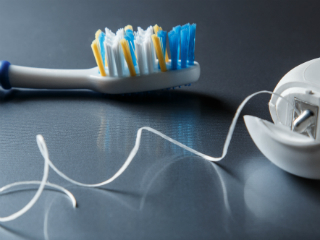 Today’s article is a guest post by Dr. Mark Burhenne, the #1 bestselling author of The 8-Hour Sleep Paradox. As an authority on dental health, he is also on a mission to help shift the conversation about sleep from quantity to quality as the foundation for primal living. As a member of the American Academy of Dental Sleep Medicine, Dr. Burhenne blogs about the mouth-body connection on his website, AsktheDentist.com. Today, he addresses some of the most pressings topics surrounding oral health from an ancestral health perspective, which , if you think about it, can be summed up with the following question: If Grok didn’t floss his teeth, why should I, especially when I’m living a primal lifestyle?
Today’s article is a guest post by Dr. Mark Burhenne, the #1 bestselling author of The 8-Hour Sleep Paradox. As an authority on dental health, he is also on a mission to help shift the conversation about sleep from quantity to quality as the foundation for primal living. As a member of the American Academy of Dental Sleep Medicine, Dr. Burhenne blogs about the mouth-body connection on his website, AsktheDentist.com. Today, he addresses some of the most pressings topics surrounding oral health from an ancestral health perspective, which , if you think about it, can be summed up with the following question: If Grok didn’t floss his teeth, why should I, especially when I’m living a primal lifestyle?
Here we go:
What happens in your mouth affects the rest of your body, which is why your oral health is an essential part of primal living.
There’s no bypassing the mouth. And if you don’t take care of what’s inside of it, you could have more to worry about than just cavities and fillings. Today, our mouths can be a source of many problems that ail us—like poor sleep quality and poor microbiome health. But even more seriously, studies have shown that bad bacteria in the mouth can contribute to cardiovascular disease, dementia, preterm labor, pancreatic cancer, diabetes, and more.
Poor oral health has effects downstream in the body. And poor systemic health in the rest of the body can show up in the mouth—it’s a two-way street.
Obviously, Grok was not aware of this, but he didn’t have to worry about this mouth-body connection. Why? His diet matched his biology, his lifestyle was more suitably adapted to his surroundings, and, as a result, he didn’t have to deal with the onslaught of negative epigenetic influences that we do today.
But let me back up a bit. This story begins when Grok was an infant.
From the moment Grok was born, he was breastfed. Baby Grok sucked on a fleshy (not plastic) nipple, which helped develop a perfect swallow and tongue reflex. There was no transition from sippy cups to soft baby food—he went from mother’s milk to unrefined, unprocessed foods, which had the toughness necessary to stimulate proper jaw development. A well-developed jaw meant his airway had plenty of room at the back of the throat to stay wide open even during the muscle collapse in deep stages of sleep, allowing him to get as much HGH (human growth hormone) as possible each night. HGH bolstered the immune system, warded off disease, and allowed Grok to be his best and brightest each day. His diet was rich in organ meats and bone marrow (Vitamin K2), which also promoted proper development of the lower third of the face, allowing for straight teeth and a wide airway for uninterrupted sleep. Baby Grok was also born vaginally, which exposed him to a host of beneficial bacteria, establishing a robust oral microbiome.
By comparison, modern humans are exposed to sippy cups, pacifiers, plastic nipples, and soft processed foods starting from birth. As a result, the lower third of the face is underdeveloped in most of the population, leading to snoring, sleep-disordered breathing, and sleep apnea even in people who are young and in shape. For modern people, braces are so common they’re nearly a rite of passage, but rarely do we stop to think that those crowded teeth are a result of a jaw that never got to grow to its full size thanks to a childhood diet of applesauce and crackers. Modern humans are also more likely to be born by C-section—a medical necessity in our modern world, but with consequences to the microbiome.
The result? Modern humans suffer from gum disease and cavities at high rates of 60% and 90%, respectively. Instead of addressing the root cause, we scrape away at the problem by brushing and flossing. But brushing and flossing don’t come without a consequence—every time we brush, we create a bacteremia (bacteria in the blood, which is normally sterile). Bacteremia appears within 60 seconds and lasts for at least 20 minutes, which shows just how connected the mouth is to the rest of the body. But those bacteria are quite different from what they used to be during Grok’s day—because of our modern diet, the biofilm is thicker, so there’s less exposure of the teeth to oxygen and saliva, changing the makeup of bacteria in the mouth. The oxygen-hating bacteria (anaerobes) have become much more dominant in the mouth, changing the makeup of our oral microbiome.
To make matters worse, many people use antibiotic mouthwashes on a daily basis. This is like using a nuclear bomb in the mouth—killing off both good and bad bacteria and causing them to grow back in the wrong ratio, making the oral environment even more dysbiotic.
Cavities, crooked teeth, poor sleep, and chronic disease are seen as normal in the modern world, whereas in Grok’s, they were rare.
What Happens in the Mouth Happens in the Body
Like I said earlier, oral infection, especially gum disease, may affect the course and the manner of the development of many systemic diseases, such as breast cancer, pneumonia, diabetes, and even low birth weight and preterm delivery.
The most well-known mouth-body connection is the one between gum disease and heart disease, including several studies that show a relationship between gum disease and stroke. A common bug in the mouth that causes gum disease is also found in the endothelial cells in the walls of hardened arteries. It’s clear that inflammation in the mouth isn’t contained—it spreads to the rest of the body. And 70-90% of people living in the US have some sort of inflammation in the mouth.
Pneumonia can result from infection by anaerobic bacteria. Dental plaque and calculus are the source of these bacteria, more likely in patients with periodontal disease. Such patients harbor a large number of bacteria below the gum line where oxygen is less prevalent. Studies have shown that people with respiratory disease have significantly higher oral hygiene issues than people without respiratory disease.
Periodontal disease is also seen as an early complication of diabetes. So much so that a dentist can detect undiagnosed diabetes and even early prediabetic conditions just by performing an oral exam.
Given all these correlations, it shouldn’t come as a complete surprise that gum disease has been regarded as a stronger indicator of total mortality risk than coronary artery disease.
So it’s time to control the environment and not the bacteria—something Grok did every day of his life, just by living his life in a way that matched his evolutionary biology.
So here’s how to optimize your moth-body health the primal way.
Diet is most important
Thankfully, the primal way of eating helps to optimize oral health by protecting teeth from acid attacks and promoting good oral microbiome health. Proper nutrition allows the pulp to heal the tooth from the inside and it nourishes the oral microbiome, allowing the tooth to be healed from the outside. This dual front optimization allows the tooth to continually renew itself.
If you’re able to breastfeed your children, do so
Afterwards, go straight to foods with substance, like sugar snap peas and salmon jerky, which promote proper development of the lower third of the face and airway.
Keep your kids away from sippy cups and pacifiers
Transition kids directly to a stainless steel cup, like Caveman Cups.
See the right dentist
See a dentist who is concerned with facial development, or trained in Orthotropics (I recommend finding an orthodontist here.)
Get enough Vitamin K2
This nurtient helps both kids and adults. In kids, Vitamin K2 promotes straight teeth and proper development, and in adults, it keeps teeth strong, promotes remineralization of the teeth, and prevents heart disease. The modern diet is devoid of Vitamin K2 in large part because our animals are no longer pasture-raised and we no longer consume organ meats.
Throw away your mouthwash
If you’re worried about bad breath, suck on oral probiotic lozenges and get a tongue scraper. Eating the proper foods and taking a probiotic will address the root cause of bad breath.
Floss
For those of you who can truly say you are eating like Grok 100% of the time, then theoretically, you wouldn’t have any need to floss. But we are so removed from our ancestral diets that it is impossible to eat as our ancestors did. In a perfect world, we’d be eating a diet that nurtures the biofilm, instead of eating a diet that alters it to the point where we have to remove it daily to prevent disease. Eating a diet that requires the scrubbing of the teeth afterwards is a perfect example of how we have drifted from the harmonious matching of diet to health.
So even though flossing may not seem like the best fix for this mismatch between our diet today and our evolutionary origins, it’s certainly become a necessity of our modern lifestyle. So don’t stop!



May 2, 2016
Dear Mark: Is Caloric Density the Answer?, Fat Starving the Brain, and High-Intensity Primal Endurance Training
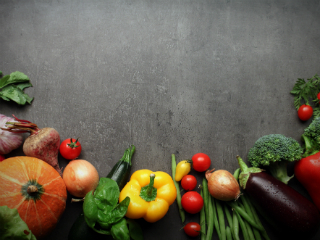 For today’s edition of Dear Mark, I’m answering three questions from readers. First, should the primary focus in constructing a healthy diet be caloric density? Is the key to weight loss and optimal health the consumption of bulky, low-calorie foods? Next, a new study seems to show that fat “starves the brain.” Is this true? If not, what’s really going on? And finally, are following Primal Endurance principles antithetical to high intensity performance?
For today’s edition of Dear Mark, I’m answering three questions from readers. First, should the primary focus in constructing a healthy diet be caloric density? Is the key to weight loss and optimal health the consumption of bulky, low-calorie foods? Next, a new study seems to show that fat “starves the brain.” Is this true? If not, what’s really going on? And finally, are following Primal Endurance principles antithetical to high intensity performance?
Let’s find out.
Dear Mark,
recently I stumbled upon the whole plant-based diet revolution, specifically the website of Michael Greger, nutritionfacts.org.
I thought I understood the way blood sugar works and how carbs can mess that up. However, the plant-based diet relies heavily on whole wheat grains. These are doctors claiming that caloric density is the answer to choosing the right type foods. They essentially fill your stomach entirely without consuming a lot of calories, in a nutshell. More food for less calories if that makes sense.
What do you make out of this, and what’s your take specifically on the caloric density theory?
Thanks in advance and keep up the good work!
Joost Smit
I’ve spoken about caloric density before. But while mechanically filling up your gut with a high volume of low-caloric food (like non-starchy vegetables) can “fill you up,” it misses the boat.
I prefer to focus on nutrient density. This way all bases are covered, you’re getting actual nutrients, and you can eat a wider range of foods. If you eat a high-caloric density food, you make sure it’s also high in nutrient density. Foods like meat, nuts and seeds, hard cheese, eggs, beets, and baked Japanese sweet potatoes (and regular potatoes) qualify. And when you eat a low-caloric density food, you make sure it’s not just empty roughage providing little else but bulk. Foods like leafy greens, broccoli, and other vegetables qualify. Food should serve a purpose besides bulk, whether it’s providing protein, fat, prebiotics, magnesium, iodine, polyphenols, or any other macro or micronutrient vital for health.
Focusing only on caloric density leaves out a lot of foods and predisposes you to focus on the wrong ones. You’ll miss out on animal products and all the important nutrients they contain, because they’re high in calories. You’ll miss out on gouda and all the vitamin K2, calcium, and beneficial fats it contains because it’s calorically dense. You won’t eat many almonds, cashews, walnuts, or mac nuts because they contain too many calories per unit of mass.
You can certainly lose a lot of weight eating only calorically-sparse foods, and weight loss tends to confer many benefits, but you’ll be missing a lot as well. Focus on nutrient density first.
Mark,
There’s a new media report circulating showing that a high-fat diet “starves the brain.” What do you make of it? Here’s the report I saw: https://www.mpg.de/10478525/fat-brain...
Oh yeah, I saw this pop up in my Twitter feed awhile back and thought to myself “I’m gonna have to talk about this, aren’t I?” So here I am. As I knew I would be.
First, don’t worry too much about this. What the report describes is physiological insulin resistance.
In the context of high fat intakes, body-wide insulin resistance commences. This prevents precious sugar from being used needlessly by the peripheral tissues (which can rely on fat and ketones) and reserves it for the only organ that absolutely requires it: the brain (which can, of course, also use ketones, just not exclusively). Ketosis is well-known to reduce glucose consumption in the brain; this is simply because part of the brain can use ketones.
As for high-fat starving the brain of glucose? Well, the study only lasted a few days. It takes at least a few days for the body to become fat-adapted and able to convert and burn enough ketones to make up for the reduced glucose available to the brain. That’s why initial low-carbing causes cognitive deficits in the early few days, and subsequent maintenance of and adaptation to the high-fat intakes resolves the deficits.
Another point mentioned is that the “selfish brain…gets its glucose by stimulating the body’s appetite for sweet foods.” Yes, the hypothalamus can make powerful suggestions about food choice. Oftentimes the suggested food is high in sugar. And many people assent to these suggestions, but many don’t. We aren’t mice. Mice have less executive functioning than humans. They don’t “decide” a whole lot. They don’t weigh options or mull over the health effects of that high-sugar, high-fat chow. They just do what their brain suggests. Humans have the luxury of decisions, and the right decisions become a whole lot easier when you’ve been exposed to the Primal fat-versus-sugar-burning paradigm.
Of course, this is why high-fat, high-carb diets don’t work very well. You’d better pick one to focus on. If you’re smart about it, eating carbs around high intensity training, creating glycogen debts that are then repaid without impacting ketone production, you can get by. But for regular old lab mice sitting around in cages or sedentary humans wolfing down fast food meals, the carb-fat marriage is a discordant one.
Hey Mark,
Heard you on Joe Rogan’s podcast and loved what you had to say. Gorged on the Primal Blueprint and immediately picked up Primal Endurance – both are fantastic! I’m now two months into primal and love how I’m feeling.
I am also applying your rule of 8 weeks minimum aerobic base training – not just because you recommended it, but because I discovered that age 31, I developed an atrial flutter that required an ablation! My coach and cardiologist both enthusiastically endorsed your recommendation of 8 weeks’ base below MAT. It is shocking to me how the more recent trends in cycling and sports training is forcefully pushing high intensity, shorter duration work for its quick benefits rather than focusing on long-term health. Only recently have stories come out regarding cyclists and heart health, and the evidence all supports your advice to really stringently build a base before adding intensity for long-term heart health.
My question is this: because we know that more sprint-intensive activities like hard racing for an hour require longer and more training above MAT levels, and as the science shows that a low carb diet can lower high-end power output, can you point me to any guidance from you or others regarding integrating more carbohydrates around build and race phases? After reading Primal Endurance, I’m still a bit in the dark as to how the principals can work for year-long high-intensity racers.
Keep up the good work man. I’m preaching primal to everyone I can, and I’m already hearing success stories from folks feeling great.
Thanks,
Triston
At some point in the journey for elite status, some amount of health is probably sacrificed at the altar of performance. But at age-group levels just below that, I believe you can get to 90-95% of your personal max potential without doing significant harm. It’s that last 5% that kills people, but also lets you win the elite races—so you have to ask is it worth it. I eventually determined it wasn’t, and I was one of the top guys actually qualified to ask that question. Most folks who run, even the really good ones, aren’t in the same arena. For them, it’s probably not worth it.
As far as Primal Endurance training and high intensity workouts, there are acute carb loading strategies that allow for higher intensity workouts and races without compromising fat burning and/or keto utilization, like a sweet potato the night before to top off glycogen stores, the use of one of the new keto drinks just before or during, or the use of UCAN Superstarch (whose slow absorption has minimal impact on insulin and thus ketones) occasionally in a workout or race. The real key is to create a glycogen debt with training, and then fill it—but no more than that. Once you push past the amount of carbohydrate your body needs to fill glycogen stores, you’re compromising ketone production and fat adaptation.
Even after your 8 week MAT base training you won’t need to spend a ton of time at race pace in your training. You’ll need to do SOME, but maybe that’s a TT (time trial) once every two weeks if you’re not racing. Remember, Ironman triathlete Mike Pigg got to the top and stayed for a long while just doing efficiency work at sub threshold intensity between events and using weekly races as his ONLY hard workouts.
It’s easier (and healthier) than most people think to get good, but harder (and less healthy) to become elite.
Thanks for reading, everyone. Be sure to leave any comments or advice you have down below.




May 1, 2016
Weekend Link Love – Edition 398
 I invited an LA Times reporter out for some Ultimate several Sundays back. Sounds like he had a good time.
I invited an LA Times reporter out for some Ultimate several Sundays back. Sounds like he had a good time.
Research of the Week
Even folks with genetic predispositions toward depression improve with exercise.
Swiss cheese goes way back.
Childhood obesity is still increasing.
Dark chocolate boosts athletic performance (similar to beets).
Deep voices probably evolved to intimidate other men, not attract women.
Each additional hour of sedentary time is tied to higher coronary calcium scores.
Eating too much fructose can negatively affect gene expression in the brain, but enough DHA reverses it.
New Primal Blueprint Podcasts

Episode 117: Michelle Norris: I sit down with the CEO and Managing Event Coordinator of Paleo f(x), Michelle Norris, to chat about the purpose of Paleo f(x), what health practitioners, laypeople, and entrepreneurs can get from it, and how Michelle plans to change the world.
Each week, select Mark’s Daily Apple blog posts are prepared as Primal Blueprint Podcasts. Need to catch up on reading, but don’t have the time? Prefer to listen to articles while on the go? Check out the new blog post podcasts below, and subscribe to the Primal Blueprint Podcast here so you never miss an episode.
10 Common Primal Mistakes You Might Be Making
Why What You Walk (or Run) on Matters
Why Saying “No” is So Important
Interesting Blog Posts
“It’s impossible to be a vegan.” A smart kid ponders life, death, and the cyclical nature of everything.
Shroom guru Paul Stamets on the new CRISPR-edited button mushroom.
Are ravens as smart as chimps?
Media, Schmedia
Israel and McDonald’s duke it out.
The push to make California cannabis cultivation more sustainable.
Everything Else
How chronic hookworm infections the “lazy southerner” stereotype.
Me too, Ted. Me too.
Fitness, video-gamified.
Chris Masterjohn started a podcast.
The hot pepper as revolutionary barometer: “In Sichuan…eating spicy food has come to be regarded as an indication of such personal characteristics as courage, valor, and endurance.” These virtues are arguably just as useful on the toilet the morning after a spicy food binge as they are fighting Japanese imperialism.
Wildlife have taken over the Chernobyl Exclusion Zone.
A German city is putting traffic lights on the ground because people won’t look up from their phones.
Even if I was onboard with the principles, I refuse to go something called “vego.”
Recipe Corner
Gai yang, or Thai grilled chicken. Brings back memories for me.
Fried green plantains with mango avocado salsa may not be “traditional,” but dang if it isn’t good.
Time Capsule
One year ago (May 4 – May 10)
The Primal Community is More Diverse Than You Might Think – Who are we?
How We’re Setting Our Kids Up to Be Fat, Sick, and Unhappy – We’re blowing it.
Comment of the Week
Try walking through a public park full of dog poop. That’s one way to indulge in unpredictability while walking on a natural surface.
April 30, 2016
Dark Chocolate Brazil Nut and Coconut Bars
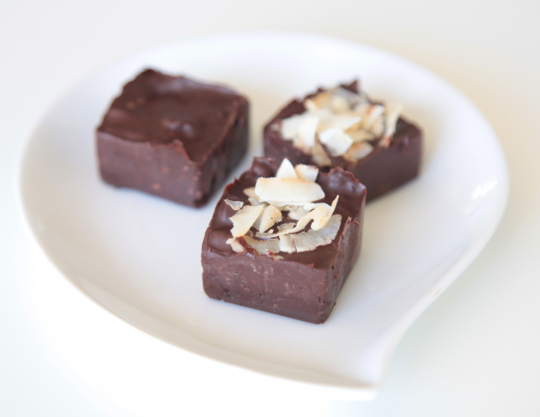
Looking for a new homemade dessert to satisfy your sweet tooth? One that’s fancy enough to serve at a dinner party, but can also be thrown into a backpack on your next hike?
These dark chocolate coconut and Brazil nut bars are pretty to look at, easy to make, stay fresh for weeks and are filled with healthy fats, flavanols, and selenium. What more could you possibly want from dessert?
The idea to use a silicone ice cube tray for shaping chocolate comes from this recipe for dark chocolate snack bites. Pouring warm chocolate into a small ice cube tray yields nicely shaped, nicely sized chocolate squares.
The possibilities here are endless. Any type of nut or seed, dried fruit, sea salt, spices like cinnamon or turmeric…they can all be used to embellish the flavor of dark chocolate.
Servings: 15 small chocolate squares
Time in the Kitchen: 15 minutes, plus 2 to 3 hours for chocolate to set
Ingredients:
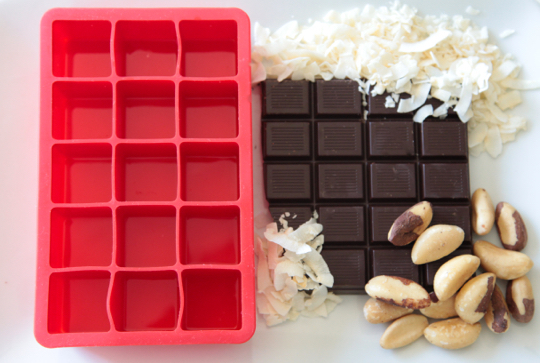
1.25 ounces (about 1/2 cup) unsweetened coconut flakes (56 g)
8 ounces high-quality dark chocolate (230 g)
1 ounce Brazil nuts (about 8 whole nuts), chopped (36 g)
Equipment:
1 silicon ice cube tray (with 15 cubes)
Instructions:
Recipe Tip: For easiest removal, lightly oil the silicon ice cube tray.
Preheat oven to 350 °F.
Spread coconut out on a baking sheet. Bake until lightly browned, 4 to 5 minutes. Remove and cool. Pulse in a food processor a few times to chop the coconut flakes into smaller pieces.
Use a serrated knife to chop the chocolate into tiny pieces. Put half the chocolate in a bowl and microwave for 1 minute. Stir in the remaining chocolate. If needed, continue heating the chocolate in 15-second intervals and then stirring, until completely melted.
Stir the coconut and chopped Brazil nuts into the chocolate. Pour the chocolate into each cube in the tray (using a bowl with a pour spout makes this easier). The chocolate will come about halfway up each cube. If desired, ingredients can also be pressed onto the top of the chocolate squares (like coconut flakes or dried fruit).

Put the tray in the refrigerator until the chocolate is completely set, 2 to 3 hours.
Carefully remove the chocolate squares from the tray. Store in an airtight container in the pantry, or in the refrigerator if your house is warm. The chocolate bites will keep for several weeks.
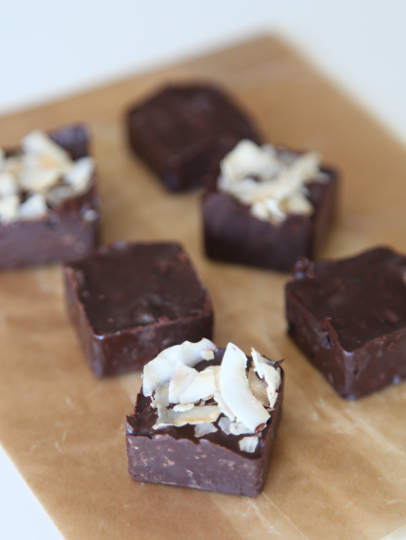




Mark Sisson's Blog
- Mark Sisson's profile
- 199 followers



